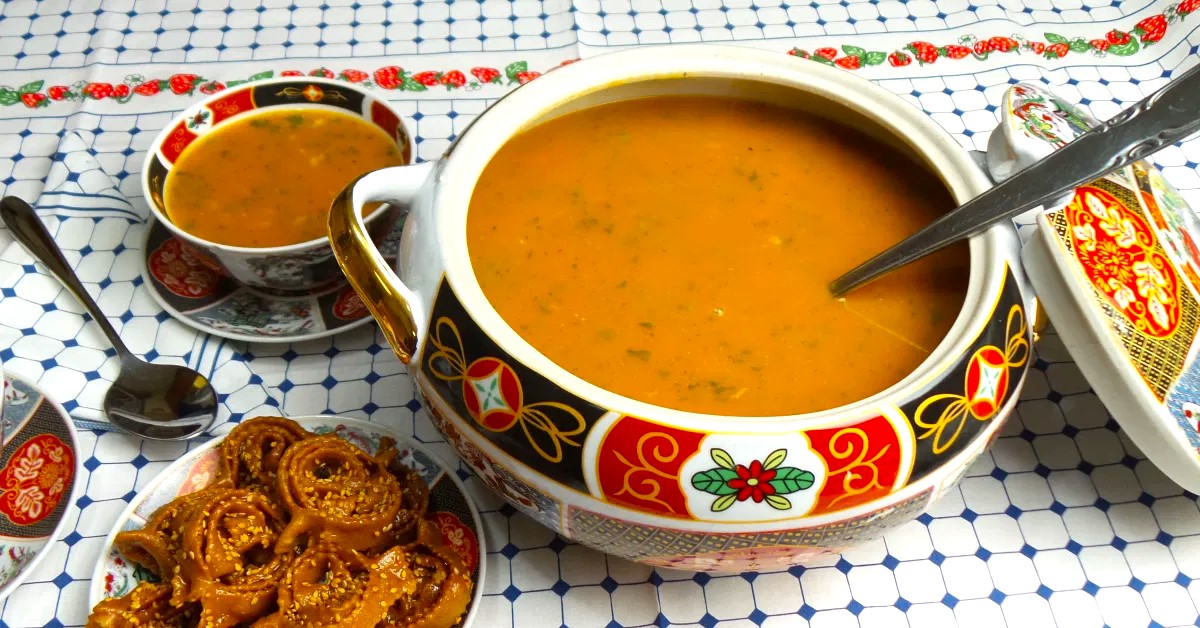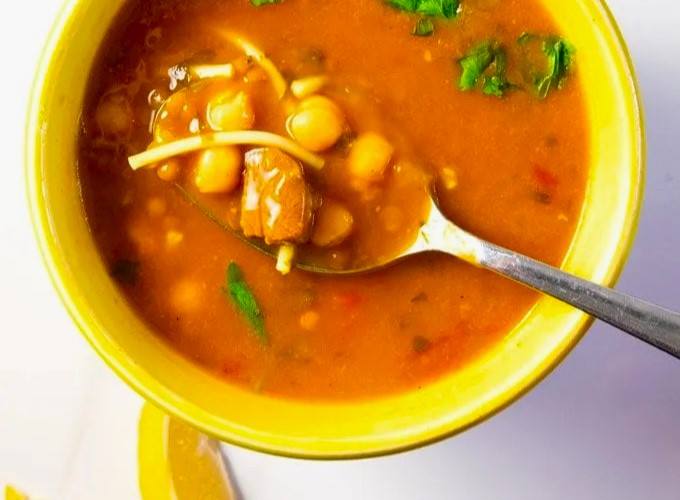Moroccan Harira: Legendary Soup That Warms the Soul
Few dishes capture the essence of Moroccan culture like Harira, a fragrant soup that blends tomatoes, lentils, chickpeas, herbs, and tender meat into a comforting, aromatic experience. Often associated with Ramadan and festive gatherings, Harira is more than food — it is a symbol of family, hospitality, and tradition.
The origins of Harira are deeply rooted in Morocco’s culinary history, combining Berber, Arab, and Andalusian influences. Each family and region has its own take, making every bowl a unique story of Moroccan flavors.
What makes Harira unforgettable is its complex layering of ingredients and spices, including coriander, parsley, cinnamon, and ginger, creating a taste that is both hearty and fragrant. Served traditionally with dates, chebakia, or fresh bread, Harira is a complete culinary experience, reflecting Morocco’s culture of sharing and celebration.
Want to explore more Moroccan culinary treasures? Try the Moroccan Tagine for another iconic dish full of slow-cooked flavors and spices.

The Story Behind Harira: Morocco’s Beloved Soup
Harira is more than a soup; it is a culinary emblem of Morocco that embodies the country’s history, culture, and hospitality. Its origins are traced to Moroccan and Andalusian kitchens, where early recipes combined local legumes, herbs, and spices to create a nourishing and aromatic dish.
Traditionally, Harira is associated with Ramadan, when families and communities gather to break the fast. The soup provides energy and warmth, often served with dates, honey, or traditional pastries like chebakia. Beyond Ramadan, Harira is enjoyed at weddings, festivals, and family gatherings, making it a symbol of togetherness and celebration.
Each Moroccan region adds its distinct touch, using local ingredients and variations in spices. The dish reflects centuries of cultural exchange, blending Berber, Arab, and Mediterranean influences into a harmonious bowl.
Travelers eager to explore Moroccan cuisine can also experience the rich flavors of Moroccan Tagine, another iconic dish that highlights Morocco’s slow-cooked, spice-rich culinary traditions.
Ingredients That Make Harira Irresistible
The magic of Harira comes from its combination of fresh, wholesome ingredients and aromatic spices, resulting in a soup that is both nourishing and deeply flavorful.
Legumes and Grains
Harira is traditionally made with lentils, chickpeas, and sometimes rice or vermicelli, providing a hearty base that makes the soup filling and energizing. These ingredients reflect Morocco’s agricultural heritage and the Berber tradition of using local staples.
Meat and Aromatics
Many versions of Harira include lamb, beef, or chicken, slow-cooked to absorb the rich spices and herbs. Onions, garlic, and tomatoes form the aromatic foundation, while fresh herbs like parsley and coriander brighten the flavor. This combination creates the signature depth and warmth that makes Harira so beloved.
Spices That Define Moroccan Cuisine
Harira’s flavor comes from a careful balance of cinnamon, ginger, turmeric, and pepper. Some recipes also include ras el hanout, a traditional Moroccan spice blend. These spices create a complex and comforting aroma, which is characteristic of Moroccan cuisine.
Finishing Touches
Before serving, Harira is often garnished with fresh herbs and a squeeze of lemon, which enhances the soup’s freshness. It is traditionally accompanied by chebakia or fresh bread, completing a meal that is rich in culture and taste.
Travelers exploring Morocco can pair Harira with other iconic dishes for a full culinary journey, such as the flavorful Moroccan Tagine, offering a slow-cooked taste of Morocco’s spice-rich heritage.
Exploring Harira Variations: From Classic to Creative
While the essence of Moroccan Harira lies in its comforting blend of legumes, meat, and aromatic spices, cooks across Morocco have developed unique regional versions that reflect the country’s culinary diversity. From traditional Ramadan soups to modern adaptations, each bowl tells a story of flavor and heritage.
Classic Harira
The classic Moroccan Harira soup remains the nation’s signature dish, made with tomatoes, lentils, chickpeas, and tender lamb or beef. Slowly simmered to perfection, it’s often paired with chebakia, a honey-coated sesame cookie, or freshly baked bread. This hearty soup plays an essential role during Ramadan, providing nourishment and comfort after the day’s fast.

Harira with Mhamsa
A beloved regional variation includes mhamsa, small Moroccan pasta pearls that add body and texture. This version of Harira is thicker and more filling, perfect for chilly evenings or festive gatherings. Mhamsa-based Harira highlights the creativity and adaptability of Moroccan home cooking, blending local ingredients with time-honored methods.

vegetarian harira
Vegetarian Harira replaces meat with extra vegetables while maintaining the authentic base of lentils, chickpeas, and tomatoes. Enhanced with spices like ginger, turmeric, and cinnamon, it captures the essence of Moroccan cuisine — flavorful, wholesome, and inclusive. This version makes Harira accessible to a wider audience, including those who follow plant-based diets.

What are you waiting for?
Contact Holiday Morocco Tours to craft your unforgettable culinary journey, from hands-on couscous cooking classes and market explorations to authentic dining experiences in Morocco’s vibrant cities.
Bring the flavors of Morocco to life and savor an experience you will never forget.
Crafting Harira: Traditional Cooking Techniques
Making authentic Harira is both an art and a science, combining careful preparation, timing, and layering of flavors. Each step contributes to the soup’s signature richness and aromatic depth.
Preparing the Base
The process begins with sautéing onions, garlic, and tomatoes, forming a flavorful foundation. These ingredients are slowly cooked to release their natural sweetness and create a balanced aromatic base. Adding spices like cinnamon, ginger, turmeric, and black pepper infuses the soup with its characteristic Moroccan warmth.
Cooking the Legumes and Meat
Lentils, chickpeas, and meat (commonly lamb, beef, or chicken) are added and simmered until tender. Slow cooking allows the flavors to meld together, creating a rich, hearty broth. For vegetarian versions, the meat is omitted, and additional vegetables or legumes are used to maintain the texture and heartiness.
Incorporating Herbs and Grains
Fresh herbs such as parsley and coriander are added near the end to brighten the flavor. Some variations include mhamsa pasta or rice, which is carefully stirred in to enhance the soup’s body and texture. Proper timing ensures the grains are cooked perfectly without becoming mushy.
Finishing Touches
Before serving, Harira is often garnished with fresh herbs and a squeeze of lemon, which elevates the flavors and adds freshness. Traditionally, it is served with chebakia, dates, or fresh bread, creating a complete Moroccan culinary experience.
Travelers looking to experience Moroccan cooking firsthand can join culinary tours, where they learn to prepare, season, and serve Harira, gaining insight into Moroccan kitchen traditions and family rituals.
For those exploring Morocco’s rich cuisine, pairing Harira with the flavorful Moroccan Tagine creates a full journey through Morocco’s iconic dishes, from hearty soups to slow-cooked, spice-infused stews.
Where to Taste Authentic Moroccan Couscous
To truly appreciate Moroccan couscous, travelers should experience it in its authentic setting, whether in bustling cities, rural villages, or coastal towns. Sampling couscous where it is traditionally prepared provides a cultural and culinary immersion like no other.
Fes: The City of Culinary Refinement
In Fes, couscous is a centerpiece of both daily meals and festive occasions. Family-run restaurants and traditional riads serve lamb or chicken couscous with seven vegetables, infused with saffron and regional spices. Dining in Fes allows travelers to taste recipes that have been preserved for generations, offering a direct connection to Morocco’s culinary heritage.
Marrakech: Vibrant Flavors in the Heart of the Medina
Marrakech offers a sensory feast. Street vendors, local markets, and riads provide couscous with sweet dried fruits, slow-cooked meats, and aromatic spices. Exploring the Marrakech medina while tasting couscous gives travelers a true sense of the city’s vibrant culture and history.
Rural Villages and Mountain Towns
In the Rif Mountains and rural areas, couscous is often vegetarian or paired with local meats, highlighting seasonal vegetables and herbs. Visiting a traditional Moroccan home for couscous is a unique opportunity to experience authentic hospitality, witness the steaming process, and enjoy the dish with locals.
Coastal Towns: Fresh and Light Couscous
On the Atlantic coast, particularly in Essaouira, couscous is often paired with fresh seafood, reflecting the region’s maritime influence. Local chefs combine fish, vegetables, and spices to create a dish that is light, flavorful, and uniquely coastal.
Culinary Tours and Classes
For travelers seeking a hands-on experience, joining a Moroccan culinary tour or cooking class provides an intimate look at couscous preparation. Participants can steam the semolina, layer vegetables, and cook meat, learning the techniques, flavors, and traditions that make Moroccan couscous unforgettable.
Exploring Moroccan couscous across regions allows travelers to taste history, culture, and family traditions in every bite. It is more than a dish, it is a gateway to understanding Morocco’s rich culinary heritage.
Discover Moroccan Couscous: A Culinary Journey You Can Taste
Moroccan couscous is more than just a dish, it is a symbol of tradition, hospitality, and cultural heritage. From the aromatic spices and tender meats to the colorful seasonal vegetables and dried fruits, every couscous dish tells a story of regional flavors, family traditions, and centuries of culinary artistry.
Whether enjoyed in Fes, Marrakech, the Rif Mountains, or the coastal city of Essaouira, couscous provides a direct connection to Morocco’s heart and history.
